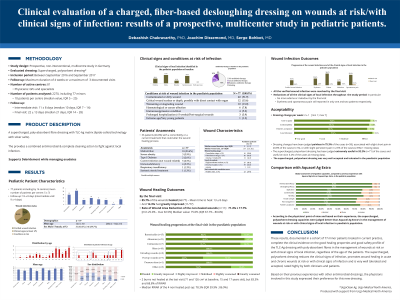Clinical Research
(CR-005) Clinical evaluation of a charged fiber based desloughing dressing on wounds at risk/with clinical signs of infection: results of a prospective, multicenter study in pediatric patients.

A charged fiber based desloughing dressing that incorporates also the lipidocolloid technology with silver (abbreviated as TLC-Ag) can help in the healing process of wounds at risk or with clinical signs of local infection in paediatric patients treated under real-life conditions. We studied such a dressing with respect to safety and efficacy in pediatric patients.
Methods: A large, prospective, multicentre, observational study was conducted on 2270 patients treated with the evaluated dressing. Main outcomes included the reduction of the number of infected wounds, the evolution of the clinical signs of local infection, wound healing rate, relative wound area reduction (RWAR), local tolerability, handling and acceptance of the dressing. The results presented here will focus on the outcomes achieved in paediatric patients.
Results:
: A total 77 paediatric patients (2-17 years old) with wounds of various aetiologies were treated in 16 centres for a mean duration of 18±8 days. The wound infections and all the clinical signs of wound infection substantially reduced since the first visit (after 9±4 days of treatment) and throughout the treatment period. By the last visit, 86% of the wounds healed and 14% greatly improved (median RWAR of 75%). The dressing has been judged very easy to apply and very conformable, it was very well tolerated and accepted by both patients and healthcare professionals. These results, documented in a cohort of 77 paediatric patients treated in current practice, comfort and complete the clinical evidence on the good healing properties and safety profile of the TLC-Ag desloughing dressing in the management of wounds at risk or with clinical signs of local infection.
Discussion:
Trademarked Items: Urgoclean Ag
References: 1.Desroche N, et al. Antibacterial properties and reduction of MRSA biofilm
with a dressing combining poly-absorbent fibres and a silver matrix. J Wound Care. 2016 Oct;25(10):577-84.
2.Percival SL. Restoring balance: biofilms and wound dressings. J Wound Care. 2018 Feb;27(2): 102-13
3.Desroche N, et al. Evaluation of in vitro anti-biofilm activities of two dressings with poly-absorbent dressing fibres and a DACC coated dressing. Poster EWMA 2017
4.Meaume, S., Dissemond, J., Addala, A. Evaluation of two fibrous wound dressings for the management of leg ulcers: results of a European randomised controlled trial (EARTH RCT). J Wound Care 2014; 23: 3, 105–116.
5.N. Desroche et al, Evaluation of the anti-biofilm activity of a new poly-absorbent dressing with a silver matrix*using a complex in vitro biofilm model. Poster Wounds UK 2017.
6.Lazareth I, et al. The role of a silver releasing lipido-colloid contact layer in venous leg ulcers presenting inflammatory signs suggesting heavy bacterial colonization: Results of a randomized controlled study. Wounds. 2008;20(6):158–66
7.Dalac S., Sigal L., Addala A., et al Clinical evaluation of a dressing
with poly absorbent fibres and a silver matrix for managing chronic wounds at risk of infection: a non-comparative trial. J Wound Care, Vol 25, No 9, September 2016

.png)
